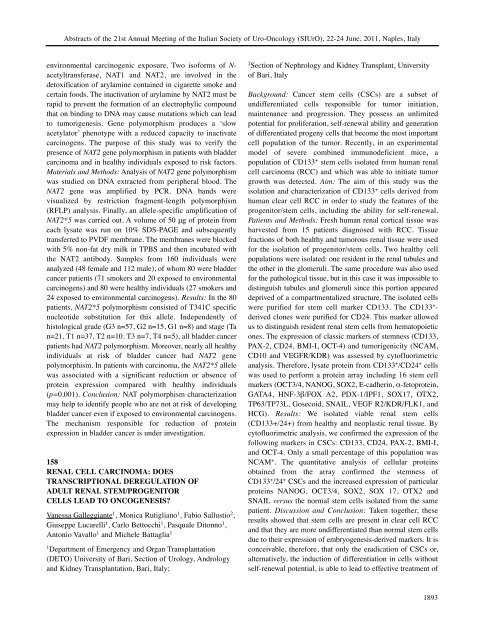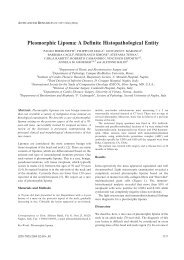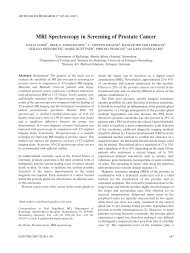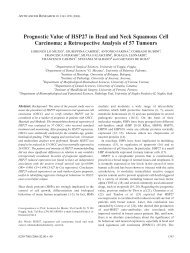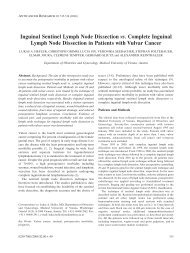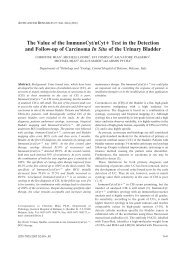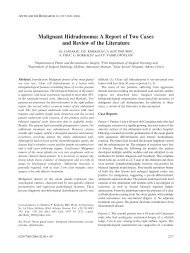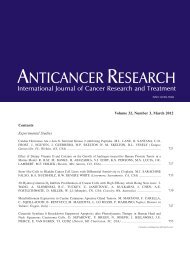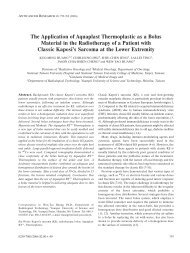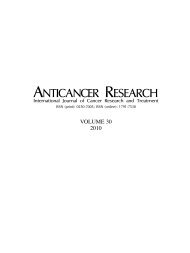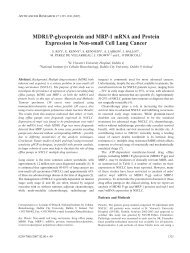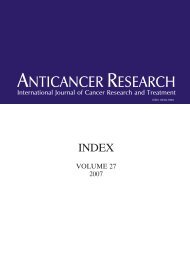ABSTRACTS OF THE 21st ANNUAL MEETING OF THE ITALIAN ...
ABSTRACTS OF THE 21st ANNUAL MEETING OF THE ITALIAN ...
ABSTRACTS OF THE 21st ANNUAL MEETING OF THE ITALIAN ...
You also want an ePaper? Increase the reach of your titles
YUMPU automatically turns print PDFs into web optimized ePapers that Google loves.
Abstracts of the <strong>21st</strong> Annual Meeting of the Italian Society of Uro-Oncology (SIUrO), 22-24 June, 2011, Naples, Italy<br />
environmental carcinogenic exposure. Two isoforms of Nacetyltransferase,<br />
NAT1 and NAT2, are involved in the<br />
detoxification of arylamine contained in cigarette smoke and<br />
certain foods. The inactivation of arylamine by NAT2 must be<br />
rapid to prevent the formation of an electrophylic compound<br />
that on binding to DNA may cause mutations which can lead<br />
to tumorigenesis. Gene polymorphism produces a ‘slow<br />
acetylator’ phenotype with a reduced capacity to inactivate<br />
carcinogens. The purpose of this study was to verify the<br />
presence of NAT2 gene polymorphism in patients with bladder<br />
carcinoma and in healthy individuals exposed to risk factors.<br />
Materials and Methods: Analysis of NAT2 gene polymorphism<br />
was studied on DNA extracted from peripheral blood. The<br />
NAT2 gene was amplified by PCR. DNA bands were<br />
visualized by restriction fragment-length polymorphism<br />
(RFLP) analysis. Finally, an allele-specific amplification of<br />
NAT2*5 was carried out. A volume of 50 μg of protein from<br />
each lysate was run on 10% SDS-PAGE and subsequently<br />
transferred to PVDF membrane. The membranes were blocked<br />
with 5% non-fat dry milk in TPBS and then incubated with<br />
the NAT2 antibody. Samples from 160 individuals were<br />
analyzed (48 female and 112 male), of whom 80 were bladder<br />
cancer patients (71 smokers and 20 exposed to environmental<br />
carcinogens) and 80 were healthy individuals (27 smokers and<br />
24 exposed to environmental carcinogens). Results: In the 80<br />
patients, NAT2*5 polymorphism consisted of T341C specific<br />
nucleotide substitution for this allele. Independently of<br />
histological grade (G3 n=57, G2 n=15, G1 n=8) and stage (Ta<br />
n=21, T1 n=37, T2 n=10. T3 n=7, T4 n=5), all bladder cancer<br />
patients had NAT2 polymorphism. Moreover, nearly all healthy<br />
individuals at risk of bladder cancer had NAT2 gene<br />
polymorphism. In patients with carcinoma, the NAT2*5 allele<br />
was associated with a significant reduction or absence of<br />
protein expression compared with healthy individuals<br />
(p=0.001). Conclusion: NAT polymorphism characterization<br />
may help to identify people who are not at risk of developing<br />
bladder cancer even if exposed to environmental carcinogens.<br />
The mechanism responsible for reduction of protein<br />
expression in bladder cancer is under investigation.<br />
158<br />
RENAL CELL CARCINOMA: DOES<br />
TRANSCRIPTIONAL DEREGULATION <strong>OF</strong><br />
ADULT RENAL STEM/PROGENITOR<br />
CELLS LEAD TO ONCOGENESIS?<br />
Vanessa Galleggiante1 , Monica Rutigliano1 , Fabio Sallustio2 ,<br />
Giuseppe Lucarelli1 , Carlo Bettocchi1 , Pasquale Ditonno1 ,<br />
Antonio Vavallo1 and Michele Battaglia1 1Department of Emergency and Organ Transplantation<br />
(DETO) University of Bari, Section of Urology, Andrology<br />
and Kidney Transplantation, Bari, Italy;<br />
2Section of Nephrology and Kidney Transplant, University<br />
of Bari, Italy<br />
Background: Cancer stem cells (CSCs) are a subset of<br />
undifferentiated cells responsible for tumor initiation,<br />
maintenance and progression. They possess an unlimited<br />
potential for proliferation, self-renewal ability and generation<br />
of differentiated progeny cells that become the most important<br />
cell population of the tumor. Recently, in an experimental<br />
model of severe combined immunodeficient mice, a<br />
population of CD133 + stem cells isolated from human renal<br />
cell carcinoma (RCC) and which was able to initiate tumor<br />
growth was detected. Aim: The aim of this study was the<br />
isolation and characterization of CD133 + cells derived from<br />
human clear cell RCC in order to study the features of the<br />
progenitor/stem cells, including the ability for self-renewal.<br />
Patients and Methods: Fresh human renal cortical tissue was<br />
harvested from 15 patients diagnosed with RCC. Tissue<br />
fractions of both healthy and tumorous renal tissue were used<br />
for the isolation of progenitor/stem cells. Two healthy cell<br />
populations were isolated: one resident in the renal tubules and<br />
the other in the glomeruli. The same procedure was also used<br />
for the pathological tissue, but in this case it was impossible to<br />
distinguish tubules and glomeruli since this portion appeared<br />
deprived of a compartmentalized structure. The isolated cells<br />
were purified for stem cell marker CD133. The CD133 + -<br />
derived clones were purified for CD24. This marker allowed<br />
us to distinguish resident renal stem cells from hematopoietic<br />
ones. The expression of classic markers of stemness (CD133,<br />
PAX-2, CD24, BMI-I, OCT-4) and tumorigenicity (NCAM,<br />
CD10 and VEGFR/KDR) was assessed by cytofluorimetric<br />
analysis. Therefore, lysate protein from CD133 + /CD24 + cells<br />
was used to perform a protein array including 16 stem cell<br />
markers (OCT3/4, NANOG, SOX2, E-cadherin, α-fetoprotein,<br />
GATA4, HNF-3β/FOX A2, PDX-1/IPF1, SOX17, OTX2,<br />
TP63/TP73L, Gosecoid, SNAIL, VEGF R2/KDR/FLK1, and<br />
HCG). Results: We isolated viable renal stem cells<br />
(CD133+/24+) from healthy and neoplastic renal tissue. By<br />
cytofluorimetric analysis, we confirmed the expression of the<br />
following markers in CSCs: CD133, CD24, PAX-2, BMI-I,<br />
and OCT-4. Only a small percentage of this population was<br />
NCAM + . The quantitative analysis of cellular proteins<br />
obtained from the array confirmed the stemness of<br />
CD133 + /24 + CSCs and the increased expression of particular<br />
proteins NANOG, OCT3/4, SOX2, SOX 17, OTX2 and<br />
SNAIL versus the normal stem cells isolated from the same<br />
patient. Discussion and Conclusion: Taken together, these<br />
results showed that stem cells are present in clear cell RCC<br />
and that they are more undifferentiated than normal stem cells<br />
due to their expression of embryogenesis-derived markers. It is<br />
conceivable, therefore, that only the eradication of CSCs or,<br />
alternatively, the induction of differentiation in cells without<br />
self-renewal potential, is able to lead to effective treatment of<br />
1893


